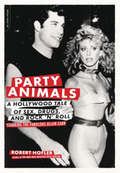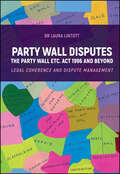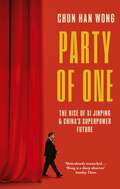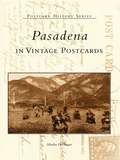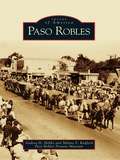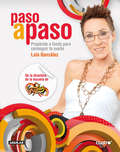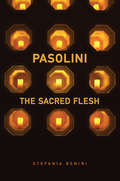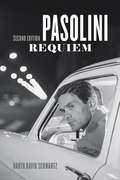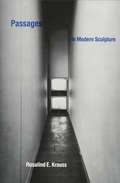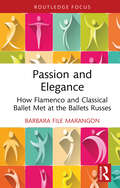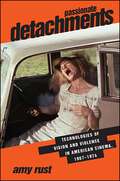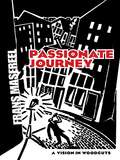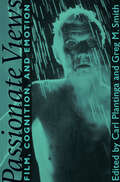- Table View
- List View
Party Animals: A Hollywood Tale of Sex, Drugs, and Rock 'n' Roll Starring the Fabulous Allan Carr
by Robert HoflerAllan Carr was Hollywood's premier party-thrower during the town's most hedonistic era--the cocaine-addled, sexually indulgent 1970s. Hosting outrageous soirees with names like the Mick Jagger/Cycle Sluts Party and masterminding such lavishly themed opening nights as the Tommy/New York City subway premiere, it was Carr, an obese, caftan-wearing producer--the ultimate outsider--who first brought movie stars and rock stars, gays and straights, Old and New Hollywood together. From the stunning success of Grease and La Cage aux Folles to the spectacular failure of the Village People's Can't Stop the Music, as a producer Carr's was a rollercoaster of a career punctuated by major hits and phenomenal flops--none more disastrous than the Academy Awards show he produced featuring a tone-deaf Rob Lowe serenading Snow White, a fiasco that made Carr an outcast, and is still widely considered to be the worst Oscars ever. Tracing Carr's excess-laden rise and tragic fall--and sparing no one along the way--Party Animals provides a sizzling, candid, behind-the-scenes look at Hollywood's most infamous period.
Party Origami: Instructions for 14 Party Decorations
by Jessica OkuiTransform beautiful origami paper into covetable party accents! With a booklet featuring step-by-step folding diagrams, eye-catching party props are just a few folds away. Origami enthusiasts and fans of pretty paper accents will enjoy folding chopstick rests, napkin rings, place settings, invitations, and more, in a range of colors and patterns.
Party Wall Disputes: The Party Wall etc. Act 1996 and Beyond - Legal Coherence, Disputes and Management
by Laura LintottAn accessible roadmap to the complexities of party wall disputes Party Wall Disputes: The Party Wall etc. Act 1996 and Beyond - Legal Coherence and Dispute Management meets the need for a roadmap to the main areas of law and fact relevant to party wall disputes: Statutes, including a detailed analysis of the Party Wall etc. Act 1996 and other relevant legislation,Property rights, such as rights of way, rights of support, drainage rights and rights linked to easements,Torts, such as nuisance related to noise and vibration and breaches of rights to light, andFactual matters, such as structural issues. In addition, this book maps out the available dispute management options under the Party Wall etc. Act 1996, in court as well as alternative dispute resolution methods (arbitration, mediation, medi-arb, expert determination and early neutral evaluation). The result is an invaluable resource for lawyers, party wall surveyors, construction professionals, academics and property owners who encounter or are interested in party wall disputes. “I can say with confidence that Dr Lintott has done the professions both of the law and of surveying in particular, as well as property owners, a great service in providing something of a stocktake…, where the tectonic plates of title, use of land, statute and common law, easements, planning and construction codes, rights, liabilities and obligations all meet. … She is mindful of the reality that party wall practice is ultimately driven by mutual proprietorial and essentially practical considerations …” —THE EARL OF LYTTON
Party in a Jar: 16 Kid-Friendly Jar Projects for Parties, Holidays & Special Occasions
by Vanessa Rodriguez CoppolaFun activities and perfect party favors for birthdays, holiday parties, and more!Party in a Jar features sixteen kid-friendly craft projects that not only provide entertainment for pint-sized partygoers but also function as take-home party favors. From edible dino terrariums to holiday-themed gifts and centerpieces, these upcycled jar crafts are earth-friendly and sure to be the hit of your next get-together! Try Bumblebee Dessert Jars • Patriotic Popcorn Jars • Space Nightlight Jars • Thankful Turkey Centerpieces • Snowman Candle Jars and more
Party of One: The Rise of Xi Jinping and China's Superpower Future
by Chun Han WongFrom one of the most admired reporters covering China today, a vital new account of the life and political vision of Xi Jinping, the authoritarian leader of the People's Republic whose hard-edged tactics have set the rising superpower on a collision with Western liberal democracies.Party of One: The Rise of Xi Jinping and China's Superpower Future shatters the many myths and caricatures that shroud one of the world's most secretive political organizations and its leader. Many observers misread Xi during his early years in power, projecting their own hopes that he would steer China toward more political openness, rule of law, and pro-market economics. Having masked his beliefs while climbing the party hierarchy, Xi has centralized decision-making powers, encouraged a personality cult around himself, and moved toward indefinite rule by scrapping presidential term limits-stirring fears of a return to Mao-style dictatorship. Today, the party of Xi favors political zeal over technical expertise, trumpets its faith in Marxism, and proclaims its reach into every corner of Chinese society with Xi portraits and hammer-and-sickle logos. Under Xi, China has challenged Western preeminence in global affairs and cast its authoritarian system as a model of governance worthy of international emulation.As a China reporter for the Wall Street Journal, Chun Han Wong has chronicled Xi's hardline strategy for crushing dissent and his political repression in Hong Kong and Xinjiang. Wong spent five years in Beijing before the Chinese government forced him to leave mainland China in 2019, after which he moved to Hong Kong and continued writing about Xi's leadership. Now, Wong has drawn on his years of first-hand reporting across China to create a lucid and historically-rooted account of China's leader, and how he inspires fear and fervor in his party, his nation, and beyond.Timely, revelatory, and important, Party of One explains how the future Xi imagines for China will reshape the future of the entire world.
Party of One: The Rise of Xi Jinping and China's Superpower Future
by Chun Han WongFrom one of the most admired reporters covering China today, a vital new account of the life and political vision of Xi Jinping, the authoritarian leader of the People's Republic whose hard-edged tactics have set the rising superpower on a collision with Western liberal democracies.Party of One: The Rise of Xi Jinping and China's Superpower Future shatters the many myths and caricatures that shroud one of the world's most secretive political organizations and its leader. Many observers misread Xi during his early years in power, projecting their own hopes that he would steer China toward more political openness, rule of law, and pro-market economics. Having masked his beliefs while climbing the party hierarchy, Xi has centralized decision-making powers, encouraged a personality cult around himself, and moved toward indefinite rule by scrapping presidential term limits-stirring fears of a return to Mao-style dictatorship. Today, the party of Xi favors political zeal over technical expertise, trumpets its faith in Marxism, and proclaims its reach into every corner of Chinese society with Xi portraits and hammer-and-sickle logos. Under Xi, China has challenged Western preeminence in global affairs and cast its authoritarian system as a model of governance worthy of international emulation.As a China reporter for the Wall Street Journal, Chun Han Wong has chronicled Xi's hardline strategy for crushing dissent and his political repression in Hong Kong and Xinjiang. Wong spent five years in Beijing before the Chinese government forced him to leave mainland China in 2019, after which he moved to Hong Kong and continued writing about Xi's leadership. Now, Wong has drawn on his years of first-hand reporting across China to create a lucid and historically-rooted account of China's leader, and how he inspires fear and fervor in his party, his nation, and beyond.Timely, revelatory, and important, Party of One explains how the future Xi imagines for China will reshape the future of the entire world.
Pasadena in Vintage Postcards
by Marlin HeckmanThe postcard has been a popular part of American communication for over a century, documenting both the interest of a place and its history. Captured here in nearly 200 vintage postcards is the unique history of this California town, translated in Chippewa as "Crown of the Valley." The City of Pasadena, just north of Los Angeles, sits against the majesty of the Sierra Madre mountain range. Incorporated in 1885, the city was originally known as a resort city, filled with tourists from all over the world. Showcased here through the use of the author's personal postcard collection are vintage images of Millionaires Row, the Tournament of the Roses Parade, the Mt. Lowe Railway, and the Alpine Tavern.
Paso Robles
by Paso Robles Pioneer Museum Andrea H. Hobbs Milene F. RadfordHalfway between Los Angeles and San Francisco, the historic town of Paso Robles became known for its abundance of hot mineral springs that brought relief from pain--first for the Salinan Indians, then for the Franciscan friars. As word of the springs' healing powers spread, hotels and bathhouses were built to accommodate the tourists who came seeking cures. The little community developed steadily after 1886, when the railroad arrived and town lots were auctioned. Area homesteaders raised cattle, grew grain, and planted fruit, walnut, and almond orchards--all without irrigation. Once known as the almond capital of the world, Paso Robles' agriculture has gradually changed from dry-land farms to irrigated vineyards. Tourists are attracted to Paso Robles for its mild climate, beautiful scenery, and mineral baths, which are being revived. The area's rich heritage is portrayed through more than 200 images from public and private historical collections.
Paso a paso (Fama): Prepárate a fondo para conseguir tu sueño
by González, Lola¿Te gustaría conquistar tu sueño y no sabes por dónde empezar? ¿Fantaseas a menudo con la idea de triunfar sobre los escenarios? ¿Eres fan del programa Fama ¡a bailar! y quisieras seguir el ejemplo de alguno de los concursantes más queridos? Si harías lo que fuera por conseguir tu sueño, descubre que el secreto para alcanzarlo se esconde en tu interior. Abre bien los ojos y aprende paso a paso: - a rentabilizar tus dudas y a conocer tus limitaciones. - a cuidar tu imagen para que sea perfecta en cualquier entrevista o casting. - a valorar la importancia del trabajo y a interiorizar que la pasión y la entrega son los valores necesarios para conseguir el éxito. - a ser autodisciplinado, a escuchar, a preguntar y a trabajar en equipo. Lola González, la directora de la escuela de Fama ¡a bailar!, el programa de superación personal y de baile de más audiencia de la televisión, te ofrece en Paso a paso los mejores consejos y las anécdotas más divertidas de la escuela, y todo lo que ha aprendido como profesional de la danza y como profesora en los últimos años. Un libro divertido en el que encontrarás las herramientas necesarias para hacer realidad tu sueño.
Pasolini
by Stefania BeniniPoet, novelist, dramatist, polemicist, and filmmaker Pier Paolo Pasolini continues to be one of the most influential intellectuals of post-war Italy. In Pasolini: The Sacred Flesh, Stefania Benini examines his corporeal vision of the sacred, focusing on his immanent interpretation of the Christian doctrine of the Incarnation and the "sacred flesh" of Christ in both Passion and Death as the subproletarian flesh of the outcast at the margins of capitalism.By investigating the many crucifixions within Pasolini's poems, novels, films, cinematic scripts and treatments, as well as his subversive hagiographies of criminal or crazed saints, Benini illuminates the radical politics embedded within Pasolini's adoption of Christian themes. Drawing on the work of theorists such as Ernesto De Martino, Mircea Eliade, Jean-Luc Nancy, Alain Badiou, Giorgio Agamben, and Slavoj Žižek, she shows how Pasolini's meditation on the disappearance of the sacred in our times and its return as a haunting revenant, a threatening disruption of capitalist society, foreshadows current debates on the status of the sacred in our postmodern world.
Pasolini Requiem: Second Edition
by Barth David SchwartzPier Paolo Pasolini (1922–75) was one of the most important Italian intellectuals of the post–World War II era. An astonishing polymath—poet, novelist, literary critic, political polemicist, screenwriter, and film director—he exerted profound influence on Italian culture up to his untimely death at the age of fifty-three. This revised edition of what the New York Times Book Review has called “the standard Pasolini biography” introduces the artist to a new generation of readers. Based on extensive interviews with those who knew Pasolini, both friends and enemies, admirers and detractors, Pasolini Requiem chronicles his growth from poet in the provinces to Italy’s leading “civil poet”; his flight to Rome in 1950; the scandalous success of his two novels and political writing; and his transition to film, where he started as a contributor to the golden age of Italian cinema and ended with the shocking Salò, or the 120 Days of Sodom. Pasolini’s tragic and still unsolved murder has remained a subject of contentious debate for four decades. The enduring fascination with who committed the crime—and why—reflects his vital stature in Italy’s political and social history. Updated throughout and with a new afterword covering the efforts to reopen the investigation—and the legal maelstrom surrounding Pasolini’s demise—this edition of Pasolini Requiem is a riveting account of one of the twentieth century’s most controversial, ever-present iconoclasts.
Passage to Afghanistan
by Peter BussianIn 2001, the Taliban approved Peter Bussian's request to photograph Afghanistan, asking him to "show the world the true Afghanistan," and for the past fifteen years, he's followed through on his promise to do so. In total, Bussian has spent nearly four years on the ground in Afghanistan, traveling there as both a photojournalist and with aid organizations such as the United Nations. In this entrancing volume, Bussian presents 150 photographs of what he calls "the land that time forgot." His captivating images feature everything from jaw-dropping landscapes-jagged mountains, desolate deserts, broad planes, and lush valleys-to its passionate people-Kabul street vendors and donkey cart drivers, devout Muslims, and displaced refugees.A fascinating introduction gives perspective on the special allure of the land-a place whose mystery was described by great poets, such as Rumi and Kipling, and that today is grounded in the fierce independence of its people, a physical and mental toughness that survives, even thrives, despite forty years of uninterrupted wars, and great famines.Side-by-side with the photographs are enlightening captions to give context to the compelling, memorable images. As a compilation, this is one of the most significant visual volumes of our time. While the world is at war with terrorism, Afghanistan, for many, represents the start of it all: the home of the terrorists behind 9/11 and the physical center of where America began its war on terrorism. To understand what we are up against and what follows Western intervention, here, at last, is a visual gateway: a portal to a significant, but little-understand land.
Passage to Israel
by Karen Lehrman Bloch Chloé Simone ValdaryBursting with lush, vibrant photographs, Passage to Israel is a timeless tribute to one of the world's most soulful, resolute, and newsworthy countries. Divided into sections such as Soul, Spirit, Awe, Quiet, and Unity, the stunning images featured inside capture Israel's glorious landscapes, its city life, its culture, and its people. From an enchanting sunset over the Dead Sea to the lively city life of Tel Aviv, from colorful marketeers to families in prayer at the Western Wall, this incredible volume moves full-steam ahead past the typical postcard images of the country to showcase the character of its people and the sanctity of the land they're so resolute in preserving. Contributors to Passage to Israel include twenty-five iconic and groundbreaking photographers, acclaimed artists such as Markus Gebauer and Amit Geron, and more than 150 of their images are featured inside. As a precursor to the images is an enlightening introduction by the author, a renowned cultural critic and curator, that provides a fascinating frame for the photographs to come.Throughout, explanatory captions are featured side-by-side with the images.For a country roughly the size of New Jersey and only formally declared a state in 1948, not too long ago, Israel is easily the world's most controversial land, one that's withstood regular suicide bombing, violent attacks, and political pressure. Yet its people refuse to be silenced; they will protect their borders and they will continue to persevere.For those who've been to Israel and those who've yet to make the trip there, here, at last, is a truly immersive experience, an inspiring visual connection to a remarkable, but faraway land
Passage to Wonderland
by Michael A. AmundsonIn 1903 the Cody Road opened, leading travelers from Cody, Wyoming, to Yellowstone National Park. Cheyenne photographer J. E. Stimson traveled the route during its first week in existence, documenting the road for the state of Wyoming's contribution to the 1904 World's Fair. His images of now-famous landmarks like Cedar Mountain, the Shoshone River, the Holy City, Chimney Rock, Sylvan Pass, and Sylvan Lake are some of the earliest existing photgraphs of the route. In 2008, 105 years later, Michael Amundson traveled the same road, carefully duplicating Stimson's iconic original photographs. In Passage to Wonderland, these images are paired side by side and accompanied by a detailed explanation of the land and history depicted. Amundson examines the physical changes along "the most scenic fifty miles in America" and explores the cultural and natural history behind them. This careful analysis of the paired images make Passage to Wonderland more than a "then and now" photography book--it is a unique exploration of the interconnectedness between the Old West and the New West. It will be a wonderful companion for those touring the Cody Road as well as those armchair tourists who can follow the road on Google Earth using the provided GPS coordinates.
Passage to Wonderland: Rephotographing Joseph Stimson's Views of the Cody Road to Yellowstone National Park, 1903 and 2008
by Michael A. AmundsonIn 1903 the Cody Road opened, leading travelers from Cody, Wyoming, to Yellowstone National Park. Cheyenne photographer J. E. Stimson traveled the route during its first week in existence, documenting the road for the state of Wyoming's contribution to the 1904 World's Fair. His images of now-famous landmarks like Cedar Mountain, the Shoshone River, the Holy City, Chimney Rock, Sylvan Pass, and Sylvan Lake are some of the earliest existing photographs of the route. In 2008, 105 years later, Michael Amundson traveled the same road, carefully duplicating Stimson's iconic original photographs. In Passage to Wonderland, these images are paired side by side and accompanied by a detailed explanation of the land and history depicted. Amundson examines the physical changes along "the most scenic fifty miles in America" and explores the cultural and natural history behind them. This careful analysis of the paired images make Passage to Wonderland more than a "then and now" photography book--it is a unique exploration of the interconnectedness between the Old West and the New West. It will be a wonderful companion for those touring the Cody Road as well as those armchair tourists who can follow the road on Google Earth using the provided GPS coordinates. The University Press of Colorado gratefully acknowledges the generous support of the Charles Redd Center for Western Studies at Brigham Young University toward the publication of this book.
Passages In Modern Sculpture
by Rosalind E. KraussStudies major works by important sculptors since Rodin in the light of different approaches to general sculptural issues to reveal the logical progressions from nineteenth-century figurative works to the conceptual work of the present.
Passion and Elegance: How Flamenco and Classical Ballet Met at the Ballets Russes (ISSN)
by Barbara File MarangonThis book commences with the history of Indian, Egyptian, Arab, and flamenco dance, then compares and contrasts the history of both classical ballet and flamenco.The book outlines the early roots of flamenco in India, and the journey of the Romani through the Middle East and Europe up to their final destination in Spain. Alongside this, the history of classical ballet is detailed from its beginning in Italy to its later development in France. The book spans the period from the temples of India to Massine’s Spanish ballet, The Three-cornered Hat, for the Ballets Russes. The chronicle of flamenco's journey from India to Spain is important to understanding the development of classical ballet as it relates to The Three-cornered Hat, which is the culmination of the story. The evolution of costumes, space, scenery, and props is examined along with the historical parallels.This exploration is set to inspire and encourage choreographers to partner other dance forms with ballet as Leonide Massine did with flamenco in The Three-cornered Hat while also challenging the anthropological idea of the language of dance movement tracing the migration of people.
Passion to Dance: The National Ballet of Canada
by James NeufeldThis is the story of the National Ballet of Canada – the people, the determination, and how at sixty it is still creating new work while still representing the classics. Passion to Dance is the story of the National Ballet of Canada – the people who dreamt the company into existence, the determination needed to keep it afloat, the bumps on the road to its success, and above all, its passion for dance as a living, evolving art form. From catch-as-catch-can beginnings – borrowed quarters, tiny stages, enormous dreams the National Ballet has emerged as one of North America’s foremost dance troupes. The company at sixty is a company of its time, engaged in creating challenging new work, yet committed to maintaining the classics of the past, favourites like Swan Lake, The Nutcracker,and The Sleeping Beauty. One hundred and fifty photographs from the company’s archives illustrate this definitive history, filled with eyewitness accounts, backstage glimpses, and fascinating detail. This is a record of one of Canada’s boldest cultural experiments, a book to enjoy now and keep forever.
Passion, Death, and Spirituality
by David Sherman Kathleen HigginsRobert C. Solomon, who died in 2007, was Professor of Philosophy and Quincy Lee Centennial Professor of Business at the University of Texas, USA. As the first book comprehensively to examine the breadth of Solomon's contribution to philosophy, this volume ranks as a vital addition to the literature. It includes a newly published transcript of Solomon's last talk, which responded to Arindam Chakrabarti on the concept of revenge, as well as the considered views of prominent figures in the numerous subfields in which Solomon worked. The content analyses his perspectives on the philosophy of emotion, virtue, business ethics, and religion, in addition to philosophical history, existentialism, and the many other topics that held this prolific thinker's attention. Solomon memorably defined philosophy itself as 'the thoughtful love of life', and despite the diversity of his output, he was most drawn by central questions about the meaning of life, the essential role that emotions play in finding that meaning, and the human imperative to seek 'emotional integrity', in which one's thoughts, emotions, and actions all contribute to a coherent narrative. The essays included here draw attention to the interconnections between the issues Solomon addressed, and evince the manner in which he embodied that integrity, living a life at one with his philosophy. They emphasize the central themes of passion, ethics, and spirituality, which threaded through his work, and the way these ideas informed his views on how we should approach grief and death. The multiplicity of topics alone make this keystone work an enlightening read for a full spectrum of students of philosophy, providing much to ponder and recounting a subtle and shining example of the emotional integrity Solomon worked so hard to define.
Passionate Amateurs: Theatre, Communism, And Love
by Nicholas RidoutPassionate Amateurs tells a new story about modern theater: the story of a romantic attachment to theater’s potential to produce surprising experiences of human community. It begins with one of the first great plays of modern European theater—Chekhov’s Uncle Vanya in Moscow—and then crosses the 20th and 21st centuries to look at how its story plays out in Weimar Republic Berlin, in the Paris of the 1960s, and in a spectrum of contemporary performance in Europe and the United States. This is a work of historical materialist theater scholarship, which combines a materialism grounded in a socialist tradition of cultural studies with some of the insights developed in recent years by theorists of affect, and addresses some fundamental questions about the social function and political potential of theater within modern capitalism. Passionate Amateurs argues that theater in modern capitalism can help us think afresh about notions of work, time, and freedom. Its title concept is a theoretical and historical figure, someone whose work in theater is undertaken within capitalism, but motivated by a love that desires something different. In addition to its theoretical originality, it offers a significant new reading of a major Chekhov play, the most sustained scholarly engagement to date with Benjamin’s “Program for a Proletarian Children’s Theatre,” the first major consideration of Godard’s La chinoise as a “theatrical” work, and the first chapter-length discussion of the work of The Nature Theatre of Oklahoma, an American company rapidly gaining a profile in the European theater scene. Passionate Amateurs contributes to the development of theater and performance studies in a way that moves beyond debates over the differences between theater and performance in order to tell a powerful, historically grounded story about what theater and performance are for in the modern world.
Passionate Detachments: Technologies of Vision and Violence in American Cinema, 1967-1974 (SUNY series, Horizons of Cinema)
by Amy RustPassionate Detachments investigates the rise of graphic violence in American films of the late 1960s and early 1970s and the popular aesthetics and critical responses this violence inspired. Amy Rust examines four technologies adopted by commercial American cinema after the fall of the Hollywood Production Code: multiple-camera montage, squibs (small explosive devices) and artificial blood, freeze-frames, and zooms. Approaching these technologies as figures, as opposed to mere tools, Rust traces the encounters they mediate between perception (what one sees, hears, and feels) and representation (how those sights, sounds, and feelings make meaning). These technologies, she argues, lend shape to film violence while organizing viewers' on- and off-screen relationships to it.The result proves meaningful for an era self-consciously and perilously preoccupied with bloodshed. The post-Code period found Americans across the political spectrum demanding visual—and increasingly violent—demonstrations of presumably "authentic" realities. Corroborating fantasies of authenticity from military to counterculture, these technologies challenge them as well, pointing, however unwittingly, to the violently classed, gendered, and racialized blind spots such fantasies harbor. More broadly, the technologies answer concerns that films control violence too much or too little. Offering neither mere discourse nor mere thrills, they recover sense and sensation for all, not some, or even most, depictions of bloodshed. As figures, the devices also remediate vision and violence for film theory, which exhibits distrust for each in spite of the complexities phenomenology and psychoanalysis have brought to cinematic perception and pleasure.
Passionate Journey: A Vision in Woodcuts (Dover Fine Art, History Of Art Series)
by Frans MasereelBelgian-born Frans Masereel (1889–1972) was one of the greatest woodcut artists of the twentieth century. Ingeniously portraying the human experience through dramatic art, this novel-without-words — crafted from 167 intricate woodcuts — is considered to be the Flemish artist's masterpiece.A feast for the eyes and the imagination, this powerful visual narrative details the life of an ordinary man. From the first bustling frame to the last haunting image, we are deeply drawn into the hero's day-to-day encounters, and discover a spirit in quest — one that we can profoundly relate to, emotionally and intellectually. Through each extraordinarily vivid depiction, readers feel the hero's happiness, grief, awe, and despair.
Passionate Playgoing in Early Modern England
by Allison P. HobgoodAllison P. Hobgood tells a new story about the emotional experiences of theatregoers in Renaissance England. Through detailed case studies of canonical plays by Shakespeare, Jonson, Kyd and Heywood, the reader will discover what it felt like to be part of performances in English theatre and appreciate the key role theatregoers played in the life of early modern drama. How were spectators moved - by delight, fear or shame, for example - and how did their own reactions in turn make an impact on stage performances? Addressing these questions and many more, this book discerns not just how theatregoers were altered by drama's affective encounters, but how they were undeniable influences upon those encounters. Overall, Hobgood reveals a unique collaboration between the English world and stage, one that significantly reshapes the ways we watch, read and understand early modern drama.
Passionate Views: Film, Cognition, and Emotion
by Carl Plantinga and Greg M. SmithThe movie theater has always been a place where people come together to share powerful emotional experiences, from the fear generated by horror films and the anxiety induced by thrillers to the laughter elicited by screwball comedies and the tears precipitated by melodramas. Indeed, the dependability of movies to provide such experiences lies at the center of the medium's appeal and power. Yet cinema's ability to influence, even manipulate, the emotions of the spectator is one of the least-explored topics in film theory today.In Passionate Views, thirteen internationally recognized scholars of film studies, philosophy, and psychology explore the emotional appeal of the cinema. Employing a novel cognitive perspective, the volume investigates the relationship between genre and emotion; explores how film narrative, music, and cinematic techniques such as the close-up are used to elicit emotion; and examines the spectator's identification with and response to film characters.An impressive range of films and topics is brought together by Carl Plantinga and Greg M. Smith, including: the success of Stella Dallas and An Affair to Remember as tearjerkers; the power of Night of the Living Dead to inspire fear and disgust; the sublime evoked in The Passion of Joan of Arc, Aguirre, the Wrath of God, and The Children of Paradise; the emotional basis of film comedy as seen in When Harry Met Sally; the use of cinematic cues in Raiders of the Lost Ark and Local Hero to arouse emotions; the relationship between narrative flow and emotion in Once Upon a Time in the West and E.T.; the emotive use of music in The Elephant Man and A Clockwork Orange; Stranger than Paradise's sense of timing; desire and resolution in Casablanca; audience identification with the main characters in Groundhog Day and The Crying Game; portrayal of perversity in The Silence of the Lambs, Flaming Creatures, and Shivers; and empathy elicited through closeups of actors' faces in Yankee Doodle Dandy and Blade Runner.Passionate Views offers a new approach to our understanding of film and will be of interest to anyone fascinated by the emotional power of motion pictures and their relationship to the central concerns of our lives, as well as by the techniques filmmakers use to move an audience.
Passionate Work: Choreographing a Dance Career
by Ruth HorowitzCorps de ballet literally means the "body" of the ballet company, and it refers to the group of dancers who are not principals. Another large group of dancers puts together portfolios of work, often across several dance companies. These categories of dancers typically don't have name recognition and yet comprise the majority of professional dancers today. The ways that they stitch together careers, through dedication, grit, and no small amount of skill – and the reasons they have for doing so without the promise of fame or fortune – are telling of broader trends that shape the precarious labor of professional dance, and creative careers more generally. In Passionate Work, dance hobbyist and sociologist, Ruth Horowitz captures their stories. When creative labor is studied, it is often thought of in opposition to more conventional work, and the primary metric that distinguishes them is passion. Professional creatives are not working in the traditional sense because they are following their passion. By tracing the careers of such dancers, Horowitz troubles the binary understanding of passion and work. A career in dance requires both, and approaching her subjects through this lens allows her to explore their strategies for sustaining passion through the ups and downs of a career. Horowitz explores how dancers evaluate the rewards and challenges of a notoriously underpaid, and uncertain profession. Horowitz considers major dimensions of a career in a performing art, documenting each stage in a dancer's life. Above all, she shines a light on the strategies used to achieve a sense of biographical continuity in a world often marked by discontinuity and rupture.
